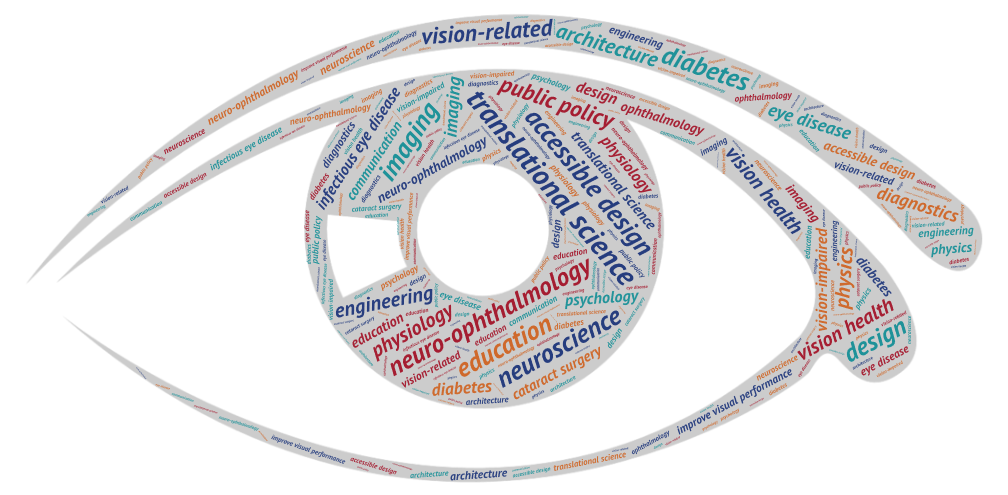News & Highlights
Topics: Funding, Pilot Funding, Technology
Eyes on the Prize
Harvard Catalyst awards five pilot grants for vision-related research.

The science of vision encompasses multiple areas of research and interdisciplinary study, from ophthalmology to education. The innovations developed to respond to eye conditions and disease draw from both low- and high-tech solutions and discoveries. Mining this rich area for promising early research was the focus of a recent pilot funding opportunity.
Launched in November 2019 by our Translational Innovator program, this pilot opportunity entitled “Sight & Science” invited applications from investigators working in both non-traditional and traditional fields of scientific research. Researchers whose projects focused not just on translational science such as treatments or biomarkers, but also on other areas of vision-related research such as educational tools or health disparities were encouraged to submit proposals.
Out of 40 applications submitted, five pilot grants of $50,000 were awarded for these one-year projects, covering topics from detecting complex text layouts of historical newspapers from a Harvard economist, to improving visual hallucinations in patients with psychosis using noninvasive brain stimulation.
One project focus is on myopia, which is currently reaching epidemic proportions within Asia and the U.S. Because of this volume of cases, screening hundreds of millions of people is prohibitive. Gang Luo, PhD, associate professor at Schepens Eye Research Institute, is hoping to solve this problem by developing an innovation that allows for greater self-care and autonomy.
“One project focus is on myopia, which is currently reaching epidemic proportions within Asia and the U.S.”
His project is a smartphone app that tests children for myopia while they are in school. Luo will use his award to test the accuracy of the app by comparing measurements taken by parents who use the app at home to the gold standard, measurements taken by a clinician. His goal is for parents to use this app to monitor myopia progression independent of the services of a healthcare professional.
The second project addresses adrenoleukodystrophy, a rare genetic disorder that mainly affects boys and men. Gene therapy has been used as a treatment to slow down the progression of the disease, whose symptoms typically begin in childhood. Currently, no tests are available to detect the visual problems which can signal the progression of cerebral adrenoleukodystrophy (cALD), the most devastating form of the disease. Lotfi Merabet, OD, PhD, MPH, associate professor at Mass Eye & Ear (MEE), will be combining the tools of virtual reality with functional brain imaging to characterize the visual progression of the disease, as well to track the progress of gene therapy in patients.
Another project will focus on improving accessibility for reading newspaper archives. Melissa Dell, PhD, professor at Harvard University’s Faculty of Arts & Sciences, will employ recent advances in deep learning to develop methods to detect the layout of historical newspapers. Since Optical Character Recognition (OCR) tools that are currently available are not effective in determining layouts of these types of documents, they are inaccessible to the visually impaired. During the course of this project, she hopes to develop an open source pipeline for document analysis and in doing so will be able to develop a structured, searchable database of newspaper content that would then make the content of these newspapers available to the visually impaired.
Combining the efficiency of contact lenses with a proposal for treating glaucoma, David Friedman, MD, PhD, MPH, professor at MEE, will conduct a small study to evaluate the effectiveness of a novel contact lens that is designed to administer a sustained release of latanoprost, which is used to treat glaucoma. The goal of using this lens is to eliminate the need for patients to take eye drops on a daily basis and reduce side effects. Friedman hopes to obtain preliminary data on the safety and comfort of a latanoprost contact lens to determine its effectiveness as a treatment for glaucoma.
The final project seeks to reduce visual hallucinations and disturbances in the field of vision among patients who suffer from these conditions. For patients who suffer from schizophrenia and other psychoses, these visual disturbances have been linked to resistance to treatment, and worsening behavioral symptoms and outcomes.
“The final project seeks to reduce visual hallucinations and disturbances in the field of vision among patients who suffer from these conditions.”
Recently, the visual cortex, the area of the brain that processes visual hallucinations, has been identified as a location which could be targeted using noninvasive brain stimulation. Armed with this information, Paulo Lizano, MD, PhD, instructor at Beth Israel Deaconess Medical Center, will be investigating whether transcranial direct current stimulation targeted to the visual cortex region of the brain will be able to improve these visual disturbances, as well as cognition in patients with psychosis.
While COVID-19 has delayed the start of some of these projects, the investigators are advancing their work on each of these projects and generating early data on groundbreaking interventions, detection devices, and other innovations that are set to impact the health and wellbeing of those with visual impairments.

